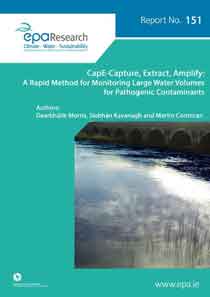Research 151: CapE-Capture, Extract, Amplify: A rapid method for monitoring large water volumes for pathogenic contaminants
Summary: This 2-year research and development project focused on validating a rapid and convenient method for screening large volumes of water for the presence of VTEC.

The incidence of human infection with verocytotoxigenic Escherichia coli (VTEC) in Ireland increases every year. Ireland consistently has the highest incidence of human infection with VTEC across Europe, with 558 cases notified to the Health Protection Surveillance Centre (HPSC) in 2012, at a crude incidence rate of 8.9/100,000 population, significantly higher than the European Union (EU) average of 1.15/100,000. The spectrum of human illness associated with VTEC is wide from self-limiting gastroenteritis to haemolytic uraemic syndrome (HUS), which is associated with fragmentation of red blood cells, renal failure and risk of death.
Approximately 10% of VTEC cases develop HUS, with those most at risk being children under 5 years of age. Those who survive may require long-term renal dialysis or kidney transplant. Water is recognised as an important transmission route.
Currently, there is no legislation requiring specific monitoring of drinking and recreational waters for VTEC. Screening for the presence of VTEC occurs only in outbreak situations, in which a 1-l sample is collected and examined. The microbiological quality of drinking and recreational water is assessed mainly by cultivation of faecal indicator bacteria – E. coli and Enterococci from small-volume (100 ml) samples taken at specific time points. Absence of E. coli and Enterococci from a 100-ml sample does not assure absence of pathogens and is limited in the ability to evaluate for low-level contamination with virulent organisms such as VTEC for which the infectious dose is very low.
The approach is also limited in that it does not differentiate between different categories of E. coli (based on virulence characteristics or antimicrobial resistance) although these may be important for public health.
This 2-year research and development project focused on validating a rapid and convenient method for screening large volumes of water for the presence of VTEC.